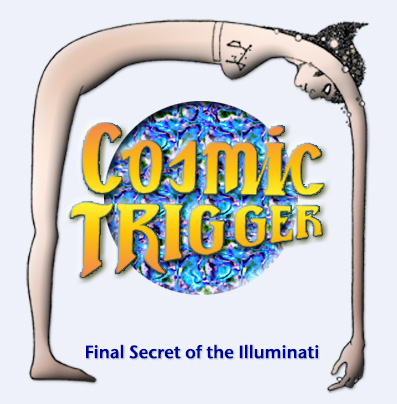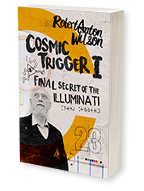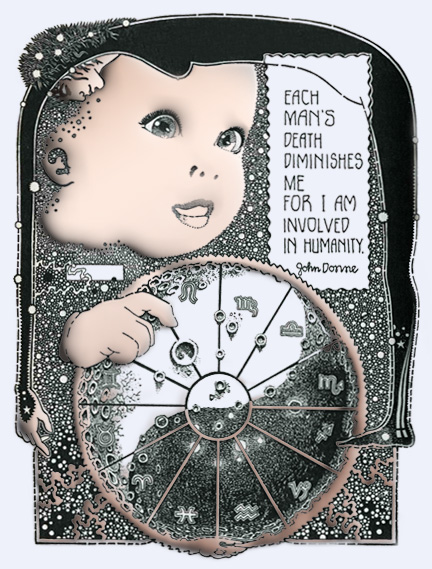Cosmic Trigger Volume I:
Final Secret of the Illuminati

Preface to the 1986 Edition
 Cosmic Trigger was originally published by And/Or Press about ten years ago, and by Pocket Books shortly thereafter. Although some of my novels have sold far better, in two dimensions at least it is my most “successful” book in human terms.
Cosmic Trigger was originally published by And/Or Press about ten years ago, and by Pocket Books shortly thereafter. Although some of my novels have sold far better, in two dimensions at least it is my most “successful” book in human terms.
- From the date of the first printing to the present, I have received more mail about Cosmic Trigger than about anything else I ever wrote, and most of this mail has been unusually intelligent and open-minded. For some reason, many readers of this book think they can write to me intimately and without fear, about subjects officially Taboo in our society. I have learned a great deal from the correspondence, and have met some wonderful new friends.
- On lecture tours, I am always asked more questions about this book than about all my other works together.
This new edition presents an opportunity to answer the most frequent questions and to correct the most persistent misunderstandings.
It should be obvious to all intelligent readers (but curiously is not obvious to many) that my viewpoint in this book is one of agnosticism. The word “agnostic” appears explicitly in the prologue and the agnostic attitude is revealed again and again in the text, but many people still think I “believe” some of the metaphors and models employed here. I therefore want to make it even clearer than ever before that
I DO NOT BELIEVE ANYTHING
This remark was made, in these very words, by John Gribbin, physics editor of New Scientist magazine, in a BBC-TV debate with Malcolm Muggeridge, and it provoked incredulity on the part of most viewers. It seems to be a hangover of the medieval Catholic era that causes most people, even the educated, to think that everybody must “believe” something or other, that if one is not a theist, one must be a dogmatic atheist, and if one does not think Capitalism is perfect, one must believe fervently in Socialism, and if one does not have blind faith in X, one must alternatively have blind faith in not-X or the reverse of X.
My own opinion is that belief is the death of intelligence. As soon as one believes a doctrine of any sort, or assumes certitude, one stops thinking about that aspect of existence. The more certitude one assumes, the less there is left to think about, and a person sure of everything would never have any need to think about anything and might be considered clinically dead under current medical standards, where absence of brain activity is taken to mean that life has ended.
My attitude is identical to that of Dr. Gribbin and the majority of physicists today, and is known in physics as “the Copenhagen Interpretation,” because it was formulated in Copenhagen by Dr. Niels Bohr and his co-workers c. 1926-28. The Copenhagen Interpretation is sometimes called “model agnosticism” and holds that any grid we use to organize our experience of the world is a model of the world and should not be confused with the world itself. Alfred Korzybski, the semanticist, tried to popularize this outside physics with the slogan, “The map is not the territory.” Alan Watts, a talented exegete of Oriental philosophy, restated it more vividly as “The menu is not the meal.”
Belief in the traditional sense, or certitude, or dogma, amounts to the grandiose delusion, “My current model” — or grid, or map, or reality-tunnel — “contains the whole universe and will never need to be revised.” In terms of the history of science and knowledge in general, this appears absurd and arrogant to me, and I am perpetually astonished that so many people still manage to live with such a medieval attitude.
Cosmic Trigger deals with a process of deliberately induced brain change through which I put myself in the years 1962-1976. This process is called “initiation” or “vision quest” in many traditional societies and can loosely be considered some dangerous variety of self-psychotherapy in modern terminology. I do not recommend it for everybody, and I think I obtained more good results than bad ones chiefly because I had been through two varieties of ordinary psychotherapy before I started my own adventures and because I had a good background in scientific philosophy and was not inclined to “believe” any astounding Revelations too literally.
Briefly, the main thing I learned in my experiments is that “reality” is always plural and mutable.
Since most of Cosmic Trigger is devoted to explaining and illustrating this, and since I still encounter people who have read all my writings on this subject and still do not understand what I am getting at, I will try again in this new Preface to explain it ONE MORE TIME, perhaps more clearly than before.
“Reality” is a word in the English language which happens to be (a) a noun and (b) singular. Thinking in the English language (and in cognate Indo-European languages) therefore subliminally programs us to conceptualize “reality” as one block-like entity, sort of like a huge New York skyscraper, in which every part is just another “room” within the same building. This linguistic program is so pervasive that most people cannot “think” outside it at all, and when one tries to offer a different perspective they imagine one is talking gibberish.
The notion that “reality” is a noun, a solid thing like a brick or a baseball bat, derives from the evolutionary fact that our nervous systems normally organize the dance of energy into such block-like “things,” probably as instant bio-survival cues. Such “things,” however, dissolve back into energy dances — processes or verbs — when the nervous system is synergized with certain drugs or transmuted by yogic or shamanic exercises or aided by scientific instruments. In both mysticism and physics, there is general agreement that “things” are constructed by our nervous systems and that “realities” (plural) are better described as systems or bundles of energy functions.
So much for “reality” as a noun. The notion that “reality” is singular, like a hermetically sealed jar, does not jibe with current scientific findings which, in this century, suggest that “reality” may better be considered as flowing and meandering, like a river, or interacting, like a dance or evolving, like life itself.
Most philosophers have known, at least since around 500 B.C., that the world perceived by our senses is not “the real world” but a construct we create — our own private work of art. Modern science began with Galileo’s demonstration that color is not “in” objects but “in” the interaction of our senses with objects. Despite this philosophic and scientific knowledge of neurological relativity, which has been more clearly demonstrated with each major advance in instrumentation, we still, due to language, think that behind the flowing, meandering, inter-acting, evolving universe created by perception is one solid monolithic “reality” hard and crisply outlined as an iron bar.
Quantum physics has undermined that Platonic iron-bar “reality” by showing that it makes more sense scientifically to talk only of the inter-actions we actually experience (our operations in the laboratory) ; and perception psychology has undermined the Platonic “reality” by showing that assuming it exists leads to hopeless contradictions in explaining how we actually perceive that a hippopotamus is not a symphony orchestra.
 The only “realities” (plural) that we actually experience and can talk meaningfully about are perceived realities, experienced realities, existential realities — realities involving ourselves as editors — and they are all relative to the observer, fluctuating, evolving, capable of being magnified and enriched, moving from low resolution to hi-fi, and do not fit together like the pieces of a jig-saw into one single Reality with a capital R. Rather, they cast illumination upon one another by contrast, like the paintings in a large museum, or the different symphonic styles of Haydn, Mozart, Beethoven, and Mahler.
The only “realities” (plural) that we actually experience and can talk meaningfully about are perceived realities, experienced realities, existential realities — realities involving ourselves as editors — and they are all relative to the observer, fluctuating, evolving, capable of being magnified and enriched, moving from low resolution to hi-fi, and do not fit together like the pieces of a jig-saw into one single Reality with a capital R. Rather, they cast illumination upon one another by contrast, like the paintings in a large museum, or the different symphonic styles of Haydn, Mozart, Beethoven, and Mahler.
Alan Watts may have said it best of all: “The universe is a giant Rorschach ink-blot.” Science finds one meaning in it in the 18th Century, another in the 19th, a third in the 20th; each artist finds unique meanings on other levels of abstraction; and each man and woman finds different meanings at different hours of the day, depending on the internal and external environments.
This book deals with what I have called induced brain change, which Dr. John Lilly more resoundingly calls “metaprogramming the human bio-computer.” In simple Basic English, as a psychologist and novelist, I set out to find how much rapid re-organization was possible in the brain functioning of one normal domesticated primate of average intelligence — the only one on whom I could ethically perform such risky research — myself.
Like most people who have historically attempted such “metaprogramming,” I soon found myself in metaphysical hot water. It became urgently obvious that my previous models and metaphors would not and could not account for what I was experiencing. I therefore had to create new models and metaphors as I went along. Since I was dealing with matters outside consensus reality-tunnels, some of my metaphors are rather extraordinary. That does not bother me, since I am at least as much an artist as a psychologist, but it does bother me when people take these metaphors too literally.
I beg you, gentle reader, to memorize the quote from Aleister Crowley at the beginning of Part One and repeat it to yourself if at any point you start thinking that I am bringing you the latest theological revelations from Cosmic Central.
What my experiments demonstrate — what all such experiments throughout history have demonstrated — is simply that our models of “reality” are very small and tidy, the universe of experience is huge and untidy, and no model can ever include all the huge untidiness perceived by uncensored consciousness.
I think, or hope, that my data also demonstrates that neurological model agnosticism — the application of the Copenhagen Interpretation beyond physics to consciousness itself — allows one to escape from certain limits of mechanical emotion and robot mentation that are inescapable as long as one remains within one dogmatic model or one imprinted reality tunnel.
Personally I also suspect, or guess, or intuit, that the more unconventional of my models here — the ones involving Higher Intelligence, such as the Cabalistic Holy Guardian Angel or the extraterrestrial from Sirius — are necessary working tools at certain stages of the metaprogramming process.
That is, whether such entities exist anywhere outside our own imaginations, some areas of brain functioning cannot be accessed without using these “keys” to open the locks. I do not insist on this; it is just my own opinion. Some people seem to get through this area of Chapel Perilous without such personalized “Guides.” I know of one chap who did it by imagining a super-computer in the future that was sending information backwards in time to his brain. More clever people may find even less “metaphysical” metaphors.
Ten years after the point at which this book ends, I do not care much about such speculations. Our lonely little selves can be “illuminated” or flooded with radical science-fiction style information and cosmic perspectives, and the source of this may be those extraterrestrials who seemed to be helping me at times, or the Secret Chiefs of Sufism, or the parapsychologists and/or computers of the 23rd Century beaming data backward in time, or it may just be the previously unactivated parts of our own brains. Despite the current reign of our New Inquisition, which attempts to halt research in this area, we will learn more about that as time passes. Meanwhile, agnosticism is both honest and becomingly modest….
In this connection, I am often asked about two books by other authors which are strangely resonant with Cosmic Trigger — namely VALIS by Philip K. Dick and The Sirian Experiment by Doris Lessing. VALIS is a novel which broadly hints that it is more than a novel — that it is an actual account of Phil Dick’s own experience with some form of “Higher Intelligence.” In fact, VALIS is only slightly fictionalized; the actual events on which it is based are recounted in a long interview Phil gave shortly before his death (see Philip K. Dick: The Last Testament, by Gregg Rickman.) The parallels with my own experience are numerous — but so are the differences. If the same source was beaming ideas to both Phil and me, the messages got our individual flavors mixed into them as we decoded the signals.
I met Phil Dick on two or three occasions and corresponded with him a bit. My impression was that he was worried that his experience was a temporary insanity and was trying to figure out if I was nutty, too. I’m not sure if he ever decided.
I interviewed Doris Lessing a few years ago for New Age magazine. She takes synchronicities very seriously, but was as agnostic as I am about the possibility that some of them are orchestrated by Sirians.
I heartily recommend all three volumes — VALIS, The Last Testament and The Sirian Experiments — to readers of this book. Unless you are locked into a very dogmatic reality-tunnel, you will have a few weird moments of wondering if Sirians are experimenting on us, and a few weird moments can be a liberating experience for those who aren’t scared to death by them.
What is more important than such extra-mundane speculation, I think, are practical and pragmatic questions about what one does with the results of brain change experience. It is quite easy, I have discovered by meeting many New Age people, to use the techniques in this book and go stone crazy with them. Paranoid and schizophrenic cases are quite common among those who experiment in this area. Less clinical, but socially even more nefarious, are the leagues of self-proclaimed gurus and their equally deluded disciples, who have discovered, as I did, that there are many realities (plural), but have picked out one favorite non-Occidental reality-tunnel, named it Ultimate Reality or True Reality, and established new fanaticisms, snobberies, dogmas and cults around these delusions.
There is a great deal of lyrical Utopianism in this book. I do not apologize for that, and do not regret it. The decade that has passed since the first edition has not altered my basic commitment to the game-rule that holds that an optimistic mind-set finds dozens of possible solutions for every problem that the pessimist regards as incurable.
Since we all create our habitual reality-tunnels, either consciously and intelligently or unconsciously and mechanically, I prefer to create for each hour the happiest, funniest, and most romantic reality-tunnel consistent with the signals my brain apprehends. I feel sorry for people who persistently organize experience into sad, dreary and hopeless reality tunnels, and try to show them how to break the bad habit, but I don’t feel any masochistic duty to share their misery.
This book does not claim that you “create your own reality” in the sense of total (but mysteriously unconscious) psychokinesis. If a car hits you and puts you in the hospital, I do not believe this is because you “really wanted” to be hit by a car, or that you “needed” to be hit by a car, as two popular New Age bromides have it. The theory of transactional psychology, which is the source of my favorite models and metaphors, merely says that, once you have been hit by a car, the meaning of the experience depends entirely on you and the results depend partly on you (and partly on your doctors). If it is medically possible for you to live — and sometimes even if the doctors think it is medically impossible — you ultimately decide whether to get out of the hospital in a hurry or to lie around suffering and complaining.
Most of the time, this kind of “decision” is unconscious and mechanical, but with the techniques described in this book, such decisions can become conscious and intelligent.
The last part of this book deals with the worst tragedy of my life. I want to say, without self-pity (a vice I despise) that my years on this planet have included many other terrible and punishing experiences, starting with two bouts of polio when I was a child and including dozens of other things I don’t want to complain about in public. When I write of creating a better and more optimistic reality-tunnel, of transcending ego-games, and of similar matters, it is not because I have lived in an ivory tower. It is because I have learned a few practical techniques for dealing with the brutal conditions on this primitive planet.
People at my lectures and seminars usually ask me if I am still optimistic about civilian space programs and life extension. I am more optimistic than ever. Despite the seemingly terminal case of rigidicus bureaucraticus at NASA, I have reason to believe certain European countries will soon jointly launch the kind of space migration effort advocated here; and Reagan’s SDI, for all its jingoism, means that more money will be spent on basic research than at any previous time in history.
On the life extension front, there have been several best-sellers on the subject since this book first appeared; there is interest even in the most intellectually backward part of U.S. society (namely, the Congress); and scientists in the longevity field whom I have met recently all cheerfully say they are getting more money for research than in the 70s. The breakthrough cannot be far away.
Finally as a matter of some entertainment value, not all the mail I have received about this book has been intelligent and thoughtful. I have received several quite nutty and unintentionally funny poison-pen letters from two groups of dogmatists — Fundamentalist Christians and Fundamentalist Materialists.
The Fundamentalist Christians have told me that I am a slave of Satan and should have the demons expelled with an exorcism. The Fundamentalist Materialists inform me that I am a liar, a charlatan, fraud and scoundrel. Aside from this minor difference, the letters are astoundingly similar. Both groups share in the same crusading zeal and the same total lack of humor, charity, and common human decency.
These intolerable cults have served to confirm me in my agnosticism by presenting further evidence to support my contention that when dogmas enter the brain, all intellectual activity ceases.
– Dublin 1986


